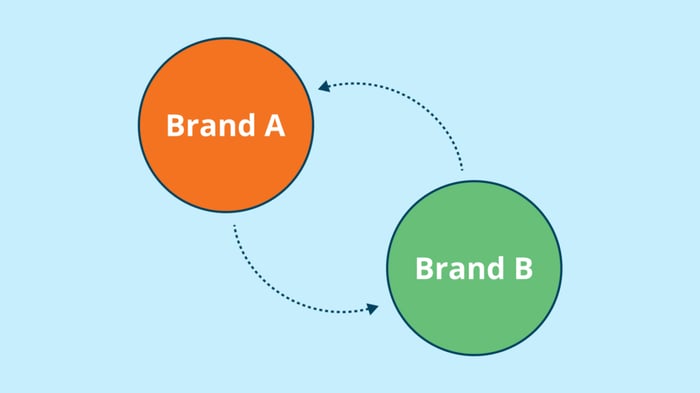In this post, we’ll take a deep dive into brand switching. We’ll explore what it means, how it affects your marketing team, and why customers can’t seem to stick to one brand.
Consider this post a compact guide to understanding the ins and outs of brand switching. We’ll lay down the key aspects encompassing the dynamics and motivations behind brand switching, why it happens, and what you can do about it.
Let’s get started.

Manage all your social media accounts in one place.
Craft, schedule, & auto-post content to all your social channels, then track analytics and manage interactions from a single, easy-to-use dashboard.
What is brand switching (and what does it mean for marketing teams)?
Brand switching is when a customer stops buying one brand’s products and chooses to buy them from a competitor. This can have a direct impact on a company’s market share. A simple example is if a consumer has always used Apple’s iPhone and then decides to buy a Samsung Galaxy, they’ve switched brands from Apple to Samsung.

Brand switching has become a central issue of customer retention, especially in today’s highly competitive landscape. With an overwhelming array of choices available to consumers, establishing brand loyalty requires a lot of effort from companies.
Customers don’t always ditch brands because of their own blunders. According to a Salesforce study, 71% of surveyed consumers confessed to brand hopping due to shifting priorities, lifestyle, or financial changes in their own lives.
If companies want to get a handle on this, they must go above and beyond to provide exceptional service and prioritize customer retention. Marketers need to answer some key questions moving forward:
- What requirements do the new generation of customers have?
- Are they tying personal, social, or environmental concerns to their purchasing decisions?
- How do your products stack up to the competition, price, and feature-wise?
Even so, brand switching is, to some extent, inevitable and is a normal part of doing business:
- 59% of customers have purchased from new brands since the COVID pandemic.
- 48% of customers have replaced products they purchased from physical stores with those from online shops.
- However, the severity of brand switching varies from industry to industry.
It’s normal for customers to switch brands in commoditized industries based on who offers the best deal or convenience at the time of purchase.
We can see this in industries like:
- Retail
- Food
- Auto repair
- Parcel delivery
All of these industries are hypercompetitive in nature. For example, there are roughly 300,000 fashion brands in the world.
With so many choices, different brands start to blur together in their look, feel, and functionality. Customers randomly go from one product to another, depending on what’s convenient and affordable when they’re shopping.
This phenomenon is known as the “commodity trap,” where brands lose their ability to command a premium due to eroded competitive advantages.
On the other hand, it’s less common for customers to switch brands in brand- or product-led industries, like:
- Fashion
- SaaS
- Electronics
- Banking
Companies in these industries find it easier to inspire brand loyalty and create emotional connections with their target customers.
How brand identity affects customer behavior

Nowadays, it’s crucial for brands to portray a clear identity. Today, customers pay attention to a company’s take on social and environmental problems as well when deciding what to buy. While these concerns apply to all industries, each company can offer a unique approach.
According to Young and Rubicam’s Value Ladder, brands that create emotional connections and a sense of belonging with customers enjoy stronger loyalty than those that don’t.
Bombarding customers with traditional advertisements simply doesn’t work well anymore, as people are used to ignoring them. Instead, personalized messages, influencer and content marketing that provide valuable information are more effective in combating brand switching.
Marketers can also showcase how their company’s initiatives contribute to making a positive difference in the world. In this sense, their products become a part of the solution which their customers can resonate with.
But creating a brand following requires more than pricing strategies and clever marketing. Companies that cultivate strong loyalty are doing a few things right.

First, successful brands tell a story that makes readers feel like they’re on the same side. Ford and Apple are great examples. They made products that were considered exclusive but were actually accessible to everyone.
Next, these brands focus on problems that their customers care about. For example, Apple answered the question of why everyone couldn’t have a computer, which really resonated with its target audience.
Today, Apple represents self-expression and embracing individuality, which appeals to modern consumers.
Building and maintaining trust is also crucial for successful brands. They give customers multiple ways to reach them, quickly resolve all issues, and prioritize data security.
Lastly, brands in product-led industries go beyond just selling products. They also show leadership in social and environmental causes.
For example, Gucci became a completely carbon-neutral brand in 2019. The fashion industry is responsible for nearly 10% of global carbon emissions, which is more than shipping and airlines combined.
By becoming carbon neutral, Gucci significantly strengthens its brand value, which helps maintain its customer base.
But why do customers switch brands in the first place?
Let’s take a look:
The driving factors behind brand switching
There are hundreds of potential factors that drive brand switching.
As such, we can’t say exactly why customers in your industry switch. But there are some proven reasons that cause customers to switch brands.
Consumers surveyed by Nielsen said they switched brands because of:
- Better value for money
- Better quality
- Better prices
- Better convenience
Basically, if there is a relevant improvement, customers are happy to switch. These factors have the most influence when two or more products can be directly compared.

However, there’s a growing trend in customers switching to brands they can better associate with or that “get them” in a way other brands don’t:
- 60% Gen-Zers’ buy from brands trying to reduce their environmental impact.
- 60% of millennials want to see brands take an active stance on racial equality.
- 35% of customers are likely to choose a brand with a strong customer loyalty program.
There are also several other factors, which are harder to quantify but no less important, that influence a consumer to choose a new brand. These include:
- Changes in household income
- Customer service experience
- Technological changes
- Political views
Chick-fil-A customers, for example, may have switched away from (or to) the brand following the reveal of their public stance on LGBT marriage.
This only goes to show that if you can establish a connection with the customer, they’d be willing to switch to your brand. (The inverse is also true).
All of this leads to the big question:
What steps can your marketing team take to better promote or avoid brand switching?
How to identify brand switching
Marketers should always try to understand changes in customer loyalty so that they may discourage brand switching as early as possible. Here are some key indicators to help you see whether customers are switching to other companies:

Poor or no reviews
Product or company reviews are usually the first indicators if something is going wrong (or right). For example, if your brand’s Facebook page is suddenly picking up 2–3 star reviews, you can bet those people are actively looking for new options. Likewise, if a new product receives no reviews, it can indicate that your customers are leaving you.
Lack of post-purchase engagement
Repeat purchases, loyalty program registration, or social media engagement can give you vital hints into customer behavior. If you’re not seeing much after-sale engagement, it might mean your customers view your product(s) as generic items and may look for replacements.
Lack of product-related inquiries
All companies receive questions about their products or services, whether before or after a sale. The more buzz a product/service creates, the better the market responds to it. On the other hand, a lack of inquiries either means your marketing isn’t effective or it offers nothing that’s already out there. In either case, brand switching is very much a possibility.
Drop in website traffic and/or social media engagement
Has your website’s bounce rate suddenly gone up? Are your social media posts not getting the views, likes, and shares they once used to? If so, your customers might be diverting their attention to other brands.
Drop in sales
If there isn’t a recession or your product/service isn’t seasonal in nature, there’s no reason you should suddenly see your sales go down. You can use your website analytics and social media presence to identify potential issues with sales.
Four data-driven ways brands can maintain customer loyalty
Customers are vocal about what they like (and don’t like) about brands.

There’s a wealth of data to draw from to help your marketing team stop customers from switching or convince them to choose your brand in place of your competitors.
Here are four customer-research-backed ways to deal with brand switching:
1. Focus on value
80% of customers indicated they’d try a new brand if it could help them achieve their goals. Factors like price, content, and engagement drive this. Agile marketing strategies can help you create a more value-driven marketing approach.
But the idea of value can change, especially if your competitors are closely imitating your products or services.
It’s always a good idea to go back to why your company was established. All entrepreneurs have a profound reason to get started. By keeping that motivation central to your daily operations and customer messaging strategy, you can stand out from the competition.
2. Support your customers
86% of customers would switch brands they trusted after just two poor customer service experiences. 52% also expect questions they post to a brand’s digital channels to be answered within one hour or less. Social media support can really come into its own here!
3. Build a great experience
62% of millennials and 60% of Gen Z’ers are willing to pay more for a better customer experience. Additionally, 70% will pay more if the brand provides a more convenient experience.
4. Address negative reviews
Most people distrust online advertising. But, 46% trust online reviews as much as a recommendation from a loved one. Also, 96% of customers specifically look for bad reviews. In fact, people distrust brands with 100% perfect reviews. It’s important to understand that bad reviews are an inevitable part of doing business. (Loomly’s Interactions feature can help you stay on top of this).
Be wary of brand fatigue: Too much sales messaging can result in customers “switching brands off.” 66% of respondents to a survey said they wanted fewer marketing messages.
What you may notice about these points is that they are all emotionally driven. They all highlight that the customer wants some appreciation and respect.
Wrapping up
Brand switching is a common behavior and is to be expected to some degree, especially in commoditized industries, but it may indicate a deeper problem in brand-led industries.
Lots of internal and external forces drive brand switching, including (but not limited to):
- Better prices, products, or customer service
- Convenience and location
- Changes in household income
- Political views
Your marketing team can either promote or avoid brand switching by focusing on emotionally driven aspects such as:
- Customer experience
- Engaging with loyal customers
- Addressing negative feedback and poor customer service
Social media is pivotal to managing brand switching. With Loomly, you can streamline your social media marketing to better engage with your customers. Start your free trial today.



